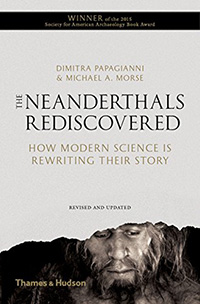 Dimitra Papagianni and Michael Morse, Neanderthals Rediscovered: How Modern Science is Rewriting Their Story (London: Thames and Hudson, 2013), 208pp.
Dimitra Papagianni and Michael Morse, Neanderthals Rediscovered: How Modern Science is Rewriting Their Story (London: Thames and Hudson, 2013), 208pp.
Since their discovery in 1856 in a German cave, Neanderthals have been subjected to numerous stereotypes, some of which are funny and harmless, but many of which are dismissive and derogatory. This book reminded me of the Flintstones cartoon of my childhood. Or to take a recent and pejorative example, Sarah Palin once dismissed a political opponent as a "knuckle dragging Neanderthal."
Thanks to a staggering number of new discoveries in the last thirty years, complimented by new technologies like DNA analysis and enhanced dating techniques, the times have changed. At the Neanderthal Museum in Germany, for example, they have used prosthetics, makeup, a stylish haircut, and a new suit of clothes to ask a tantalizing question: could such an "updated" Neanderthal walk among us today without attracting undue attention? The Neanderthals were the one of a dozen human species "most closely related to us" (Homo sapiens), and yet they were also "unmistakably different."
Neanderthals appeared 400,000 years ago, and then went extinct 40,000 years ago. They lived from the Mediterranean to Siberia and south to Gibraltar. This book is now a bit dated in this fast changing field, but Dimitra Papagianni and Michael Morse do a good job of summarizing what we do and don't know about Neanderthals, from their "origins to expansion to demise." The range of topics is familiar: their diet, dwellings, social organization, burial of the dead, cannibalism, speech, symbolic expression in art and self-adornment, so-called forward planning, and, of course, tool making. I especially enjoyed the book's 77 illustrations.
One of the most hotly debated questions about Neanderthals is how and why they vanished. The way that Papagianni and Morse address this question is indicative of the enthusiastic and yet judicious tone of their book. Despite knowing more about Neanderthals than ever before, their extinction remains "full of mystery, unresolved questions, competing and incompatible explanations, and ambiguous attributions of human bones." At the heart of this debate, and the entire book, is the deeper and even more controversial question about what it means to be human, and whether Neanderthals were more like or unlike us at some fundamental level. For a more updated book on this subject, see Rebecca Wragg Sykes, Kindred: Neanderthal Life, Love, Death and Art (New York: Bloomsbury, 2020), 400pp.
Dan Clendenin: dan@journeywithjesus.net


